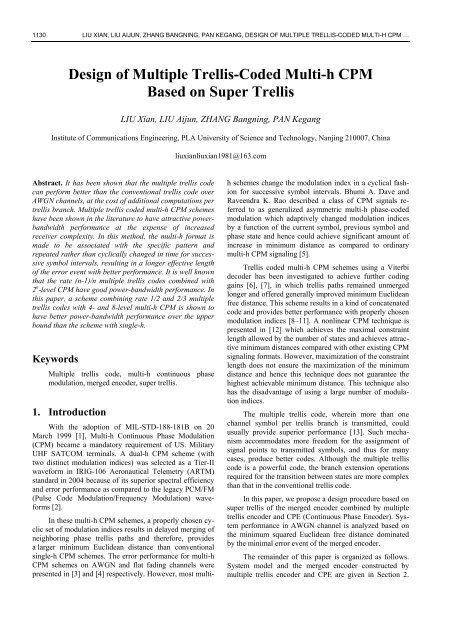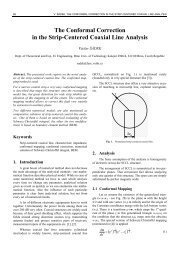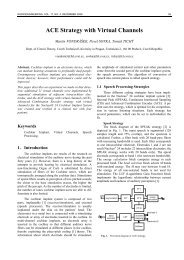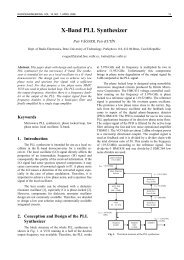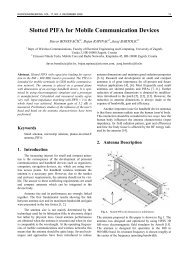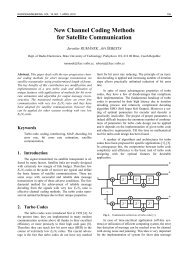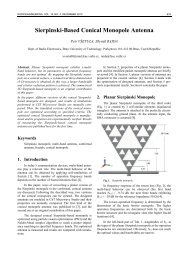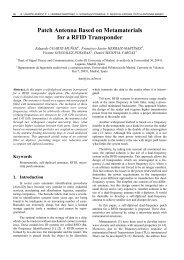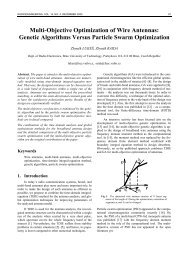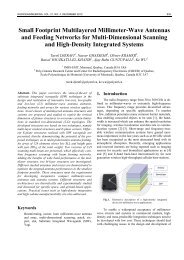Design of Multiple Trellis-Coded Multi-h CPM ... - Radioengineering
Design of Multiple Trellis-Coded Multi-h CPM ... - Radioengineering
Design of Multiple Trellis-Coded Multi-h CPM ... - Radioengineering
Create successful ePaper yourself
Turn your PDF publications into a flip-book with our unique Google optimized e-Paper software.
1130 LIU XIAN, LIU AIJUN, ZHANG BANGNING, PAN KEGANG, DESIGN OF MULTIPLE TRELLIS-CODED MULTI-H <strong>CPM</strong> …<br />
<strong>Design</strong> <strong>of</strong> <strong><strong>Multi</strong>ple</strong> <strong>Trellis</strong>-<strong>Coded</strong> <strong>Multi</strong>-h <strong>CPM</strong><br />
Based on Super <strong>Trellis</strong><br />
LIU Xian, LIU Aijun, ZHANG Bangning, PAN Kegang<br />
Institute <strong>of</strong> Communications Engineering, PLA University <strong>of</strong> Science and Technology, Nanjing 210007, China<br />
liuxianliuxian1981@163.com<br />
Abstract. It has been shown that the multiple trellis code<br />
can perform better than the conventional trellis code over<br />
AWGN channels, at the cost <strong>of</strong> additional computations per<br />
trellis branch. <strong><strong>Multi</strong>ple</strong> trellis coded multi-h <strong>CPM</strong> schemes<br />
have been shown in the literature to have attractive powerbandwidth<br />
performance at the expense <strong>of</strong> increased<br />
receiver complexity. In this method, the multi-h format is<br />
made to be associated with the specific pattern and<br />
repeated rather than cyclically changed in time for successive<br />
symbol intervals, resulting in a longer effective length<br />
<strong>of</strong> the error event with better performance. It is well known<br />
that the rate (n-1)/n multiple trellis codes combined with<br />
2 n -level <strong>CPM</strong> have good power-bandwidth performance. In<br />
this paper, a scheme combining rate 1/2 and 2/3 multiple<br />
trellis codes with 4- and 8-level multi-h <strong>CPM</strong> is shown to<br />
have better power-bandwidth performance over the upper<br />
bound than the scheme with single-h.<br />
Keywords<br />
<strong><strong>Multi</strong>ple</strong> trellis code, multi-h continuous phase<br />
modulation, merged encoder, super trellis.<br />
1. Introduction<br />
With the adoption <strong>of</strong> MIL-STD-188-181B on 20<br />
March 1999 [1], <strong>Multi</strong>-h Continuous Phase Modulation<br />
(<strong>CPM</strong>) became a mandatory requirement <strong>of</strong> US. Military<br />
UHF SATCOM terminals. A dual-h <strong>CPM</strong> scheme (with<br />
two distinct modulation indices) was selected as a Tier-II<br />
waveform in IRIG-106 Aeronautical Telemetry (ARTM)<br />
standard in 2004 because <strong>of</strong> its superior spectral efficiency<br />
and error performance as compared to the legacy PCM/FM<br />
(Pulse Code Modulation/Frequency Modulation) waveforms<br />
[2].<br />
In these multi-h <strong>CPM</strong> schemes, a properly chosen cyclic<br />
set <strong>of</strong> modulation indices results in delayed merging <strong>of</strong><br />
neighboring phase trellis paths and therefore, provides<br />
a larger minimum Euclidean distance than conventional<br />
single-h <strong>CPM</strong> schemes. The error performance for multi-h<br />
<strong>CPM</strong> schemes on AWGN and flat fading channels were<br />
presented in [3] and [4] respectively. However, most multih<br />
schemes change the modulation index in a cyclical fashion<br />
for successive symbol intervals. Bhumi A. Dave and<br />
Raveendra K. Rao described a class <strong>of</strong> <strong>CPM</strong> signals referred<br />
to as generalized asymmetric multi-h phase-coded<br />
modulation which adaptively changed modulation indices<br />
by a function <strong>of</strong> the current symbol, previous symbol and<br />
phase state and hence could achieve significant amount <strong>of</strong><br />
increase in minimum distance as compared to ordinary<br />
multi-h <strong>CPM</strong> signaling [5].<br />
<strong>Trellis</strong> coded multi-h <strong>CPM</strong> schemes using a Viterbi<br />
decoder has been investigated to achieve further coding<br />
gains [6], [7], in which trellis paths remained unmerged<br />
longer and <strong>of</strong>fered generally improved minimum Euclidean<br />
free distance. This scheme results in a kind <strong>of</strong> concatenated<br />
code and provides better performance with properly chosen<br />
modulation indices [8–11]. A nonlinear <strong>CPM</strong> technique is<br />
presented in [12] which achieves the maximal constraint<br />
length allowed by the number <strong>of</strong> states and achieves attractive<br />
minimum distances compared with other existing <strong>CPM</strong><br />
signaling formats. However, maximization <strong>of</strong> the constraint<br />
length does not ensure the maximization <strong>of</strong> the minimum<br />
distance and hence this technique does not guarantee the<br />
highest achievable minimum distance. This technique also<br />
has the disadvantage <strong>of</strong> using a large number <strong>of</strong> modulation<br />
indices.<br />
The multiple trellis code, wherein more than one<br />
channel symbol per trellis branch is transmitted, could<br />
usually provide superior performance [13]. Such mechanism<br />
accommodates more freedom for the assignment <strong>of</strong><br />
signal points to transmitted symbols, and thus for many<br />
cases, produce better codes. Although the multiple trellis<br />
code is a powerful code, the branch extension operations<br />
required for the transition between states are more complex<br />
than that in the conventional trellis code.<br />
In this paper, we propose a design procedure based on<br />
super trellis <strong>of</strong> the merged encoder combined by multiple<br />
trellis encoder and CPE (Continuous Phase Encoder). System<br />
performance in AWGN channel is analyzed based on<br />
the minimum squared Euclidean free distance dominated<br />
by the minimal error event <strong>of</strong> the merged encoder.<br />
The remainder <strong>of</strong> this paper is organized as follows.<br />
System model and the merged encoder constructed by<br />
multiple trellis encoder and CPE are given in Section 2.
RADIOENGINEERING, VOL. 21, NO. 4, DECEMBER 2012 1131<br />
Super trellis structure <strong>of</strong> the merged encoder is presented in<br />
Section 3. Section 4 presents the design procedure <strong>of</strong> the<br />
multiple trellis coded multi-h <strong>CPM</strong> system to achieve superior<br />
performance. Performance analysis is described in<br />
Section 5 and numerical results and discussion are given in<br />
Section 6. Finally, conclusions are drawn in Section 7.<br />
2. System Model<br />
2.1 <strong><strong>Multi</strong>ple</strong> <strong>Trellis</strong> <strong>Coded</strong> <strong>Multi</strong>-h <strong>CPM</strong><br />
System Description<br />
The multiple trellis coded multi-h <strong>CPM</strong> system considered<br />
in this paper is shown in Fig. 1. At epoch n, the<br />
source information bit b n is input to a multiple trellis encoder<br />
whose output is code symbol U n from the M -ary<br />
alphabet 0,1, , M 1<br />
. The code symbol U n is fed into<br />
<br />
<br />
CPE whose output is input to memoryless modulator<br />
n<br />
(MM) which completely specifies the physical phase and<br />
therefore, completely specifies the output signal. The two<br />
sub-encoders construct the merged encoder, and the analysis<br />
<strong>of</strong> overall error event is based on such merged encoder.<br />
b n<br />
bˆn<br />
U<br />
n<br />
Uˆ n<br />
<br />
<br />
<br />
n<br />
<br />
<br />
ˆn<br />
<br />
<br />
s t<br />
<br />
r t<br />
Fig. 1. Transmitter/Receiver structure <strong>of</strong> multiple trellis coded<br />
multi-h <strong>CPM</strong> system.<br />
For AWGN channels, the received signal is<br />
<br />
r t s t n<br />
t<br />
(1)<br />
where n(t) is a Gaussian random process with power spectral<br />
density N 0 W/Hz. The received signal is fed into<br />
matched filter whose output ˆn<br />
is input to Viterbi demodulator.<br />
The output <strong>of</strong> demodulator U is input to<br />
ˆn<br />
Viterbi decoder whose output b is the recovered information<br />
ˆn<br />
bits.<br />
2.2 Decomposition <strong>of</strong> <strong>Multi</strong>-h <strong>CPM</strong><br />
Rimoldi presented a tilted phase description <strong>of</strong> the<br />
single-h <strong>CPM</strong> signals in [14] by shifting the carrier frequency<br />
from f 0 to f 1 = f 0 - h(M – 1)/2T, where h is the<br />
modulation index, T is the symbol interval. The resulting<br />
modified phase (tilted phase) trellis is time invariant, and<br />
the single-h <strong>CPM</strong> modulator can be interpreted as a cascade<br />
<strong>of</strong> a linear CPE and a memoryless modulator. Saleem<br />
and Stüber showed that the tilted phase representation <strong>of</strong><br />
multi-h <strong>CPM</strong> signals results in a periodic phase trellis in<br />
[15], which enables the decomposition <strong>of</strong> multi-h <strong>CPM</strong><br />
modulator as a cascade <strong>of</strong> a periodic recursive CPE and<br />
a memoryless modulator.<br />
First, the complex envelope <strong>of</strong> a multi-h <strong>CPM</strong><br />
waveform with H different modulation indices is given by<br />
<br />
<br />
E<br />
s t, U exp jt, U 0<br />
, t 0<br />
(2)<br />
T<br />
where E is the energy per symbol, 0<br />
is a constant phase<br />
term which can be ignored if phase synchronization is<br />
assumed. The time varying phase t,<br />
U , also called the<br />
excess phase, is defined as<br />
<br />
<br />
t, U 2π<br />
h 2Un<br />
M 1 qtnT, t 0. (3)<br />
n<br />
n0<br />
H<br />
Here () H denotes the modulo H operation and the modulation<br />
index for each symbol interval is chosen cyclically<br />
from the set {h 0 ,h 1 ,…,h H – 1 }, q()is the phase shaping function.<br />
In order to ensure a finite number <strong>of</strong> states in the<br />
decoding trellis, modulation indices are restricted to the set<br />
<strong>of</strong> rational numbers with a common denominator P, such<br />
that h i = K i /P. The denominator P is always chosen such<br />
that gcd(K 0 , K 1 ,…, K H – 1 , P) = 1, where gcd() denotes the<br />
greatest common divisor <strong>of</strong> these arguments.<br />
The excess phase in (3) can be written as<br />
<br />
nL<br />
L1<br />
t, Uπh 2UiM12π 2 n i 1<br />
i<br />
h U M<br />
n i <br />
qtniT<br />
<br />
<br />
H<br />
H<br />
<br />
i0 i0<br />
Substituting = t - nT such that the interval<br />
t [nT, (n + 1)T] is equivalent to [0, T], (4) becomes<br />
nL<br />
L1<br />
nT, U2πh Ui<br />
4π<br />
i hn i U<br />
niq iT<br />
<br />
<br />
<br />
H<br />
i0 i0<br />
L1<br />
2πM 1<br />
h <br />
Un i π 1<br />
n i <br />
q iT M h<br />
<br />
<br />
H<br />
i<br />
H<br />
i0 i0<br />
(5)<br />
Second, we define the tilted phase for<br />
t [nT, (n + 1)T] as<br />
H<br />
nL<br />
(4)<br />
M h tnT<br />
n1<br />
π 1<br />
n<br />
H<br />
t, Ut, U πM 1<br />
h<br />
<br />
.<br />
i<br />
H<br />
i0<br />
T<br />
(6)<br />
Note that the sum <strong>of</strong> second and third term is actually<br />
the negative <strong>of</strong> the lowest trajectory <strong>of</strong> the excess phase<br />
trellis. When written in terms <strong>of</strong> , where [0, T], and<br />
nT, U from (5), we get<br />
substituting <br />
nL<br />
L1<br />
nT, U2πh Ui<br />
4π<br />
i hn i UniqiT<br />
<br />
<br />
<br />
H<br />
H<br />
i0 i0<br />
L1 L1<br />
πM<br />
1h<br />
<br />
n <br />
2π M 1 h q iT π M 1<br />
h<br />
ni<br />
<br />
H<br />
ni<br />
<br />
H<br />
i0 i1<br />
T<br />
H<br />
<br />
(7)
1132 LIU XIAN, LIU AIJUN, ZHANG BANGNING, PAN KEGANG, DESIGN OF MULTIPLE TRELLIS-CODED MULTI-H <strong>CPM</strong> …<br />
All the terms in nT, <br />
U are periodic in n and<br />
depend only on the time translated variable . So the tilted<br />
phase transformation turns out to be a periodic function <strong>of</strong><br />
time with period H .<br />
On the time interval, t [nT, (n + 1)T], (7) can be<br />
expressed as<br />
nL<br />
L1<br />
, U2π<br />
i<br />
4π<br />
i<br />
ni ni<br />
<br />
t h U R t nT h U q t n i T<br />
where<br />
H<br />
i0 i0<br />
R<br />
t is a data independent term, and is defined as<br />
H<br />
<br />
(8)<br />
M<br />
h <br />
t<br />
L<br />
n<br />
H<br />
ni <br />
<br />
<br />
L<br />
1 π 1<br />
1<br />
R t π M1h <br />
2π M1<br />
h q iT<br />
ni <br />
H<br />
H<br />
i1 T<br />
i0<br />
(9)<br />
The tilted phase is generated from the input symbols<br />
by the CPE <strong>of</strong> (8). The CPE is a Finite State Machine<br />
(FSM) with a periodic coefficient K . Based on the<br />
relationship between the excess and tilted phase in (6), the<br />
CPE in (8), and the phase modulator in (2), we represent<br />
the multi-h <strong>CPM</strong> modulator as a periodic CPE followed by<br />
a memoryless modulator, as shown in Fig. 2. Here<br />
Qi<br />
t, n4π<br />
Pqtn iT, the block labeled “TT”<br />
is the transformation in (6), and the double circled symbol<br />
denotes a modulo- P adder.<br />
<br />
Q t n<br />
0<br />
,<br />
U n<br />
<br />
<br />
K n H<br />
<br />
<br />
Q1 t,<br />
n QL<br />
1 t,<br />
n<br />
<br />
<br />
<br />
<br />
2π P<br />
<br />
<br />
Fig. 2. Decomposition <strong>of</strong> multi-h <strong>CPM</strong>.<br />
<br />
n H<br />
<br />
<br />
R tnT<br />
<br />
t, U<br />
<br />
<br />
t, U<br />
<br />
<br />
stU ,<br />
Unlike single-h <strong>CPM</strong>, where the state vector is defined<br />
as the cascade <strong>of</strong> the cumulative and the L 1 previous<br />
input symbols, for multi-h <strong>CPM</strong> we must also take the<br />
periodicity <strong>of</strong> the state machine into account. We define the<br />
state vector as<br />
<br />
<br />
n1<br />
, U , n<br />
(10)<br />
1<br />
<br />
n1<br />
where U , U , , U <br />
<br />
n n L n L H<br />
UnL 1 nL1 nL2 is the set <strong>of</strong> past<br />
n1<br />
symbols determining the correlative terms in the tilted<br />
phase, P<br />
n n<br />
2π , is called the cumulative phase<br />
n<br />
state. Note that (n) H is incorporated in the state vector to<br />
conform to the usual definition <strong>of</strong> a state machine, i.e., the<br />
next state and output <strong>of</strong> the CPE is determined solely by<br />
the knowledge <strong>of</strong> the previous state and current input<br />
symbol.<br />
<br />
3. Super <strong>Trellis</strong> Structure <strong>of</strong> Merged<br />
Encoder<br />
Because <strong>of</strong> the existence <strong>of</strong> periodicity in the state<br />
machine, the trellis structure <strong>of</strong> CPE decomposed by multih<br />
<strong>CPM</strong> becomes complex, and much more difficult to draw<br />
with several indices. For simplicity, the super trellis structure<br />
with single-h <strong>CPM</strong> is presented and the minimum<br />
error event based on super trellis is analyzed firstly, then<br />
the analysis will be extended to the design <strong>of</strong> multiple<br />
trellis coded multi-h <strong>CPM</strong> system.<br />
3.1 Construction <strong>of</strong> Super <strong>Trellis</strong><br />
0<br />
1<br />
00<br />
21<br />
11<br />
30<br />
03<br />
22<br />
12<br />
33<br />
0 0<br />
1<br />
03<br />
22<br />
00<br />
21<br />
CPE+MM<br />
Fig. 3. Block diagram <strong>of</strong> multiple trellis coded <strong>CPM</strong> system.<br />
The block diagram <strong>of</strong> multiple trellis coded <strong>CPM</strong> system<br />
is shown in Fig. 3. The multiple trellis encoder is<br />
a two-state conventional rate 1/2 encoder with multiple factor<br />
k 2 . Parameters <strong>of</strong> the single-h <strong>CPM</strong> signaling are<br />
defined as: M 4 , h 14, 1REC pulse shape. Such<br />
CPFSK (Continuous Phase Frequency Shift Keying) signaling<br />
with rectangular pulse shaping function with length<br />
L 1 is a simple form <strong>of</strong> full-response <strong>CPM</strong>.<br />
The super trellis is defined as S 1 S 2 , where S 1 and S 2<br />
represent the trellis state <strong>of</strong> the multiple trellis encoder and<br />
the CPE respectively. As shown in Fig. 3, the trellis state<br />
<strong>of</strong> multiple trellis encoder is defined as 0 and 1, and the<br />
trellis state <strong>of</strong> the CPE is defined as 0 , π 2 , π and 3π 2 .<br />
The super trellis structure <strong>of</strong> the merged encoder<br />
constructed by multiple trellis encoder and CPE is shown<br />
in Fig. 4. Based on the definition above, the state number<br />
<strong>of</strong> the merged encoder is the product <strong>of</strong> the state number <strong>of</strong><br />
the multiple trellis encoder and CPE, e.g., the number <strong>of</strong> S 1<br />
and S 2 is 2 and 4 respectively, so the state number <strong>of</strong> the<br />
merged encoder is 2 4 8.<br />
S1,<br />
S2<br />
0,0<br />
<br />
0,0<br />
2,1<br />
<br />
0, π 2<br />
<br />
<br />
<br />
0,0<br />
<br />
<br />
1, 2<br />
<br />
<br />
<br />
3,3 <br />
1, 2 <br />
<br />
Fig. 4. Super trellis structure <strong>of</strong> merged encoder.<br />
E 0<br />
E 1<br />
0, π<br />
0,3π 2<br />
1, 0<br />
1, π 2<br />
1, π<br />
1, 3π 2
RADIOENGINEERING, VOL. 21, NO. 4, DECEMBER 2012 1133<br />
3.2 Error Event <strong>of</strong> <strong><strong>Multi</strong>ple</strong> <strong>Trellis</strong> <strong>Coded</strong><br />
<strong>CPM</strong><br />
Based on analysis <strong>of</strong> super trellis structure as shown<br />
in Fig. 4, the occurrence <strong>of</strong> an error event <strong>of</strong> the merged<br />
encoder indicates the occurrence <strong>of</strong> the error event <strong>of</strong> the<br />
multiple trellis encoder and CPE simultaneously, and all<br />
the error events <strong>of</strong> the merged encoder must contain one or<br />
more error events <strong>of</strong> the multiple trellis encoder and CPE<br />
simultaneously. For example, an error event defining as E 0<br />
occurred when trellis paths diverge at the same super state<br />
S 1 S 2 = 0,0 and converge at the same super state<br />
S 1 S 2 = 0,3/2 after two transitions. The corresponding output<br />
<strong>of</strong> these two transitions is 0021 and 2100 respectively.<br />
The pairwise error sequence is defined as ξ , which is<br />
0021-2100 for error event E 0 .<br />
As shown in Fig. 4, there aren’t parallel branches in<br />
the super trellis structure. So the minimum number <strong>of</strong><br />
transitions <strong>of</strong> all error events is two at least, i.e., the error<br />
event with two transitions is the minimal error event, such<br />
as E 0 and E 1 . Also the number <strong>of</strong> symbols <strong>of</strong> the minimal<br />
error event is the effective length <strong>of</strong> the encoder, obviously,<br />
it is the product <strong>of</strong> the effective length <strong>of</strong> the multiple trellis<br />
encoder and CPE, e.g., the effective length <strong>of</strong> the multiple<br />
trellis encoder and CPE in Fig. 4 are both 2, so the<br />
effective length <strong>of</strong> the merged encoder is 22 4.<br />
For single-h CPFSK, the effective length <strong>of</strong> the CPE<br />
is always 2, and no matter what kind <strong>of</strong> pairwise error<br />
sequence A 1 …A j – B 1 …B j <strong>of</strong> the multiple trellis encoder is,<br />
the pairwise sequence A 1 …A j B 1 …B j – B 1 …B j A 1 …A j must<br />
be the error sequence <strong>of</strong> the merged encoder. We define the<br />
error event with such error sequence as the “back-loop”<br />
error event, which is important in the analysis <strong>of</strong> the<br />
merged encoder with multi-h <strong>CPM</strong>, and the “back-loop”<br />
error event with j k ( k is the multiple factor) must be<br />
the minimal error event in the merged encoder.<br />
4. <strong>Design</strong> Procedure<br />
The design procedure in this section could be divided<br />
into the following four steps.<br />
4.1 Maximizing the Effective Length<br />
For multiple trellis encoder, the effective length is the<br />
multiple factor k . Error events with cross transitions must<br />
have more symbols than error events with parallel transitions.<br />
Based on the analysis <strong>of</strong> the super trellis structure, the<br />
effective length <strong>of</strong> the merged encoder is the product <strong>of</strong> the<br />
effective length <strong>of</strong> multiple trellis encoder and CPE. So<br />
maximizing the effective length <strong>of</strong> the merged encoder can<br />
be divided into maximizing the effective length <strong>of</strong> multiple<br />
trellis encoder and CPE each. The effective length <strong>of</strong> CPE<br />
is always 2 for single-h <strong>CPM</strong> because <strong>of</strong> the modulo P<br />
( P is the denominator <strong>of</strong> the modulation index) adder<br />
operation. So the effective length <strong>of</strong> the merged encoder<br />
equals to 2k with single-h <strong>CPM</strong>.<br />
For multi-h <strong>CPM</strong>, the effective length <strong>of</strong> the CPE can<br />
be always increased by proper use <strong>of</strong> several indices. However,<br />
the use <strong>of</strong> greater number <strong>of</strong> indices can not always<br />
guarantee the increase <strong>of</strong> the effective length <strong>of</strong> the CPE.<br />
For example, the “back-loop” error event E 0 with single-h<br />
CPFSK “0021-2100”, at the same time, is the minimal<br />
error event <strong>of</strong> the merged encoder with dual-h CPFSK in<br />
cyclic use, i.e., the cyclic use <strong>of</strong> two indices fails to increase<br />
the effective length <strong>of</strong> the merged encoder when<br />
compared with single index. Therefore, compared with the<br />
number <strong>of</strong> indices, the proper use <strong>of</strong> them (pattern <strong>of</strong> indices)<br />
are more important in the design <strong>of</strong> maximizing the<br />
effective length <strong>of</strong> the merged encoder with multi-h <strong>CPM</strong>.<br />
4.2 Maximizing Minimum Euclidean Distance<br />
We first define D 2 () as the squared Euclidean distance<br />
with pairwise error sequence ξ , and D min as the<br />
minimum Euclidean distance among all these pairwise<br />
error sequences. For a superior code, D min is always generated<br />
by the minimal error event with effective length. In<br />
other words, if D min is generated by the error event in<br />
which the number <strong>of</strong> symbols is greater than the effective<br />
length, such code design is sure to be inferior. So the maximization<br />
<strong>of</strong> effective length and Euclidean distance is always<br />
jointly considered.<br />
For multi-h <strong>CPM</strong>, the maximization <strong>of</strong> D min can be<br />
divided into the following three steps:<br />
(1) The effective length <strong>of</strong> the merged encoder with<br />
single-h <strong>CPM</strong> is firstly analyzed, which equals to 2k ;<br />
(2) For single-h <strong>CPM</strong>, the minimum Euclidean distance<br />
D min with the effective length 2k is maximized<br />
through a computer search to find the largest Euclidean<br />
distance among the pairwise error sequences like<br />
00<br />
1 20kBB 1 2Bk BB<br />
1 2Bk00 1 2 0 with arbitrary<br />
k<br />
values <strong>of</strong> B 1<br />
B 2<br />
B k<br />
, then the superior multiple trellis<br />
code based on such D min is designed, which is described in<br />
the following subsection 4.3;<br />
(3) For multi-h <strong>CPM</strong>, the effective length is further<br />
maximized through designing the pattern <strong>of</strong> several indices,<br />
and the minimum Euclidean distance D min for multi-h <strong>CPM</strong><br />
is further maximized based on the increase <strong>of</strong> effective<br />
length, which is described as following in subsection 4.4;<br />
Since there is not any exact formula that describes<br />
D 2 () against h even for a given <strong>CPM</strong> signaling format,<br />
the maximization <strong>of</strong> D min is extremely difficult especially<br />
with several indices. For simplicity, the analysis is firstly<br />
based on the single-h <strong>CPM</strong> and then extended to multi-h<br />
<strong>CPM</strong>, firstly based on the effective length, and then extended<br />
to the minimum Euclidean distance, just as these<br />
three steps described above.
1134 LIU XIAN, LIU AIJUN, ZHANG BANGNING, PAN KEGANG, DESIGN OF MULTIPLE TRELLIS-CODED MULTI-H <strong>CPM</strong> …<br />
4.3 <strong><strong>Multi</strong>ple</strong> <strong>Trellis</strong> Code <strong>Design</strong> Following<br />
Ungerboeck’s Set Partition Rules<br />
Similarly to Ungerboeck’s TCM design [16], the following<br />
two design rules are adopted.<br />
(1) All the diverging transition outputs from each<br />
state must be unique.<br />
(2) All the merging transition outputs to each state<br />
must be unique.<br />
As an example, the multiple trellis code with dual-h<br />
<strong>CPM</strong> is designed, and parameters are listed as following:<br />
the code rate is 1/2, the state number <strong>of</strong> the multiple trellis<br />
code is 4, the multiple factor k = 3, the modulation alphabet<br />
M = 4, the modulation indices [h 0 ,h 1 ] = [3,4]/16, and<br />
the memory length L 1.<br />
As analyzed in the previous subsection, multiple trellis<br />
code with single index h 14is firstly designed. The<br />
effective length <strong>of</strong> the multiple trellis encoder and CPE is 3<br />
and 2 respectively, so the effective length <strong>of</strong> the merged<br />
encoder is 6. Then the minimum Euclidean distance is<br />
maximized through computer search among all the pairwise<br />
error sequences 000BBB<br />
1 2 3<br />
BBB<br />
1 2 3000<br />
with arbitrary<br />
B1BB.<br />
2 3<br />
The largest Euclidean distance under search is 4, and<br />
the corresponding pairwise error sequence is 000202-<br />
202000. Following Ungerboeck’s set partition rules, the<br />
multiple trellis code designed for single index CPFSK with<br />
h 14is shown in Fig. 5.<br />
In most cases, the largest Euclidean distance under<br />
search cannot be accomplished in the code design. When<br />
the pairwise error sequence achieves the largest Euclidean<br />
distance, the Ungerboeck’s set partition rules cannot always<br />
be obeyed at the same time, and other requirements<br />
are also need to satisfy which will be described later. In<br />
this case, the second or third largest Euclidean distance will<br />
be the alternative in the code design.<br />
1: 000 2: 202<br />
3: 002 4: 200<br />
5: 020 6: 222<br />
7: 220 8: 022<br />
1: 111 2: 313<br />
3: 113 4: 311<br />
5: 131 6: 333<br />
7: 331 8: 133<br />
1: 020 2: 222<br />
3: 220 4: 022<br />
5: 000 6: 202<br />
7: 002 8: 200<br />
1: 131 2: 333<br />
3: 331 4: 133<br />
5: 111 6: 313<br />
7: 113 8: 311<br />
0<br />
1<br />
2<br />
3<br />
8<br />
1<br />
0 0<br />
1<br />
2<br />
1<br />
2<br />
3 3<br />
Fig. 5. Superior design for single index with h 14.<br />
After the design above, further verifying is need to<br />
make sure that the minimum Euclidean distance generated<br />
by the pairwise error sequence 000202-202000 is actually<br />
the minimum one among all these pairwise error sequences.<br />
As shown in Fig. 5, the effective length <strong>of</strong> error events<br />
with parallel transitions and cross transitions is 3 and 6<br />
respectively. Generally speaking, the Euclidean distance <strong>of</strong><br />
error events with effective length 6 is larger than error<br />
events with effective length 3. However, the operation <strong>of</strong><br />
verifying can not be neglected. In this case, the Euclidean<br />
distance with pairwise error sequence 000000020020-<br />
020020000000 and 000000002111-002111000000 is 6.22<br />
and 4.68 respectively, which are both larger than 4 (parallel<br />
transitions), and the latter is proved to be the minimum one<br />
among all error events with cross transitions.<br />
In the design <strong>of</strong> multiple trellis code, such pairwise<br />
error sequences as A 1 A 2 A 3 and B 1 B 2 B 3 with<br />
(A 1 + A 2 +A 3 ) modP = (B 1 + B 2 +B 3 ) modP should be<br />
avoided, because such error sequences will result in the<br />
occurrence <strong>of</strong> the error event <strong>of</strong> multiple trellis encoder and<br />
CPE simultaneously. In this case, the effective length <strong>of</strong><br />
the merged encoder will be shortened as to be 3. Similar<br />
case like A 1 …A j and B 1 …B j (j < 2k) with<br />
(A 1 + … +A j ) modP = (B 1 +…+B j ) modP should also be<br />
avoided.<br />
The error sequence with h 14which generates the<br />
largest Euclidean distance is also the same error sequence<br />
with [h 0 ,h 1 ] = [3,4]/16 which also generates the largest<br />
Euclidean distance, i.e., the superior design <strong>of</strong> multiple<br />
trellis code for single index with h 14 is always the<br />
superior one for two indices with [h 0 ,h 1 ] = [3,4]/16. It can<br />
h average h , h .<br />
be proved because <br />
0 1<br />
One may doubt that the code design in Fig. 5 is not<br />
superior for single-h with h14 i.e. P 4<br />
, because<br />
the pairwise error sequence 000-202 satisfies<br />
000 mod420 2mod4. In fact it really isn’t<br />
and that doubt is reasonable.<br />
However, the code design in Fig. 5 is actually the<br />
superior one for dual-h with [h 0 ,h 1 ] = [3,4]/16 because<br />
3 33 433 mod1613341 3<br />
mod16 ,<br />
and it could be verified later.<br />
4.4 <strong>Design</strong> <strong>of</strong> Pattern <strong>of</strong> Several Indices<br />
Based on the superior design <strong>of</strong> multiple trellis code<br />
with single-h <strong>CPM</strong> in the previous subsection, the effective<br />
length with multi-h <strong>CPM</strong> can be further maximized by a<br />
proper pattern design <strong>of</strong> these several indices.<br />
Before the analysis, the state transfer diagram <strong>of</strong> the<br />
superior multiple trellis code designed above is shown in<br />
Fig. 6. As shown in the diagram, the exponent <strong>of</strong> J and<br />
D represents the number <strong>of</strong> transitions and the symbol<br />
weight respectively between two states. For example,<br />
J D<br />
2 D<br />
2<br />
represents that there are one transition and<br />
two parallel branches from the state “A” to state “B”, and<br />
the symbol weight <strong>of</strong> two branches are both 2. Note that<br />
the definition on the exponent <strong>of</strong> D is different with the
RADIOENGINEERING, VOL. 21, NO. 4, DECEMBER 2012 1135<br />
traditional analysis on the convolutional code, which is<br />
hamming distance always.<br />
<br />
2 6<br />
J D D<br />
<br />
<br />
<br />
0 4<br />
J D D<br />
4 4<br />
J D D<br />
<br />
<br />
<br />
<br />
J D D<br />
<br />
4 4<br />
J D D<br />
2 2<br />
<br />
<br />
5 9<br />
J D D<br />
<br />
3 7<br />
J D D<br />
2 2<br />
J D D<br />
<br />
<br />
<br />
<br />
7 7<br />
J D D<br />
<br />
<br />
5 5<br />
J D D<br />
<br />
<br />
<br />
5 5<br />
J D D<br />
<br />
7 7<br />
J D D<br />
<br />
<br />
<br />
3 7<br />
J D D<br />
<br />
J D<br />
<br />
4<br />
<br />
2 6<br />
J D D<br />
<br />
J D D<br />
5 9<br />
Fig. 6. State transfer diagram <strong>of</strong> the designed multiple trellis<br />
encoder.<br />
Based on the state transfer diagram, the state transfer<br />
equations are listed as follows:<br />
<br />
2 2 <br />
5 5 <br />
4 4 <br />
7 7<br />
<br />
2 6 <br />
5 9 <br />
0 4 <br />
3 7<br />
<br />
4 4 <br />
7 7 <br />
2 2 <br />
5 5<br />
<br />
4 <br />
3 7 <br />
2 6 <br />
5 9<br />
X J D D X J D D X J D D X J D D X<br />
<br />
X J D D X J D D X J D D X J D D X<br />
<br />
X J D D X J D D X J D D X J D D X<br />
<br />
<br />
XE J D X<br />
A<br />
J D D XB J D D XC J D D XD<br />
B A B C D<br />
C A B C D<br />
D A B C D<br />
<br />
<br />
<br />
(11)<br />
Solving these equations, we get the state transfer<br />
function as:<br />
<br />
T D,<br />
J<br />
<br />
JD 2J D J D J D 2J D 2J D 4J D J D 4J D<br />
<br />
1J JD4JD2JD4JD 2JD 4JD<br />
4 2 5 2 8 2 12 2 13 3 5 3 10 3 13 3 14<br />
4 5 2 5 2 10 2 13 2 14<br />
(12)<br />
4<br />
Obviously, JD is the minimum polynomial in<br />
TD,<br />
J , and it also represents the minimal error event <strong>of</strong><br />
the multiple trellis encoder, so the analysis on error events<br />
before is verified by the state transfer function, and the<br />
further maximization <strong>of</strong> effective length with several indices<br />
is just based on this state transfer function.<br />
We define as symbol difference between the two<br />
corresponding symbols and D as the sum <strong>of</strong> symbol<br />
differences in the pairwise error sequence.<br />
For single-h <strong>CPM</strong>, the design criteria is to maximize<br />
the minimal transitions which satisfies<br />
D mod P 0<br />
(13)<br />
where P is the denominator <strong>of</strong> the modulation index,<br />
which is 4 with h 14. The “back-loop” error event defined<br />
above with the pairwise error sequence 000202-<br />
202000 must satisfy (13), because D <strong>of</strong> such error<br />
event must be zero, which satisfies equation (13) obviously<br />
no matter P is. Note that the pairwise error sequence 000-<br />
202 also satisfies (13) because D <br />
4 , So the minimal<br />
transitions we could maximize is 1 actually, and the effective<br />
length <strong>of</strong> the merged encoder is shortened to be k 3.<br />
For multi-h <strong>CPM</strong> withh , 0<br />
h , 1<br />
, h<br />
1 , ,<br />
H<br />
K0 K1 KH<br />
1<br />
P,<br />
the design criteria is also to maximize the minimal<br />
transitions which satisfies<br />
<br />
K00 K11<br />
K mod P0<br />
ξ1 ξ1<br />
<br />
0 1 D<br />
1 <br />
<br />
ξ <br />
(14)<br />
D is the exponent <strong>of</strong> polynomials with dummy<br />
Here<br />
variable “ D ” in equation (12), or the addition (subtraction)<br />
<strong>of</strong> the exponent <strong>of</strong> several polynomials, which is corresponding<br />
to the concatenated error events in the pairwise<br />
error sequence. The subscript ξ is the length <strong>of</strong> the pairwise<br />
error sequence ξ .<br />
For example, we analyze the case <strong>of</strong> dual-h <strong>CPM</strong> with<br />
[h 0 ,h 1 ] = [3,4]/16 in cyclic use. “Back-loop” error events <strong>of</strong><br />
several polynomials in (12) have been checked with criteria<br />
in (14). Results are shown in Tab. 1.<br />
Polynomial Pairwise error sequence Whether satisfies (14)<br />
4<br />
JD 000202-202000 No<br />
2 4<br />
J D<br />
2 12<br />
J D<br />
000000020020-<br />
020020000000<br />
000000222222-<br />
222222000000<br />
Yes<br />
Yes<br />
<br />
Tab. 1. Validation results.<br />
From Tab. 1, pairwise error sequence 000000020020-<br />
020020000000 has been verified firstly to satisfy (14), so<br />
the minimal transitions we could maximize is 4, hence the<br />
effective length <strong>of</strong> the merged encoder with two indices<br />
[h 0 ,h 1 ] = [3,4]/16 in cyclic use is 4k 12. The effective<br />
length could be further increased by a proper pattern design<br />
<strong>of</strong> the two indices. The pattern includes the number<br />
and the periodicity <strong>of</strong> these indices. Generally speaking, it<br />
is much more complex to deal with a great number <strong>of</strong> modulation<br />
indices, and it is relatively manageable to just increase<br />
the periodicity with some few indices.<br />
For the case <strong>of</strong> two indices with [h 0 ,h 1 ] = [3,4]/16, the<br />
periodicity could be increased to QQ 3<br />
by use <strong>of</strong> the<br />
pattern like [h 0,0 , …,h 0,i-1 , h 1,0 ,…,h 1,j-1 ], (i +j = Q), which<br />
means that the number <strong>of</strong> h 0 and h 1 is i and j respectively.<br />
Obviously, the larger Q is, the larger effective length we<br />
could maximize for the merged encoder.<br />
4<br />
As we know, the minimal error event with JD and<br />
the minimal “back-loop” error event with J 2 D 0 are the<br />
“bottle-neck” in the maximization <strong>of</strong> the periodicity Q .<br />
Details <strong>of</strong> the maximization process are shown in Tab. 2.<br />
The last column indicates whether satisfying (14) with the<br />
“bottle-neck” error event or not.<br />
The largest Q we could maximize is 10 from Tab. 2,<br />
because patterns with QQ 10<br />
all satisfy (14) for the<br />
minimal “back-loop” error event. Also for arbitrary number<br />
<strong>of</strong> indices H , the maximal Q we could get is Q max = 5H,<br />
because once Q 5H<br />
, there must be one pattern with at
1136 LIU XIAN, LIU AIJUN, ZHANG BANGNING, PAN KEGANG, DESIGN OF MULTIPLE TRELLIS-CODED MULTI-H <strong>CPM</strong> …<br />
least 6 same consecutive indices, which means single index<br />
for the minimal “back-loop” error event, and then the<br />
effective length will be shorten greatly. Once the maximal<br />
Q has been achieved, the next step is to compute the<br />
effective length <strong>of</strong> the merged encoder for dual-h <strong>CPM</strong><br />
with a pattern like [h 0 ,h 0 ,h 0 ,h 0 ,h 0 ,h 1 ,h 1 ,h 1 ,h 1 ,h 1 ].<br />
Q Pattern Whether satisfies (14)<br />
3 [h 0 ,h 0 ,h 1 ] No<br />
4 [h 0 ,h 0 ,h 0 ,h 1 ] No<br />
5<br />
6<br />
7<br />
8<br />
9<br />
10<br />
[h 0 ,h 0 ,h 0 ,h 1 ,h 1 ]<br />
[h 0 ,h 0 ,h 0 ,h 0 ,h 1 ]<br />
[h 0 ,h 0 ,h 0 ,h 0 ,h 1 ,h 1 ]<br />
[h 0 ,h 0 ,h 0 ,h 0 ,h 0 ,h 1 ]<br />
[h 0 ,h 0 ,h 0 ,h 0 ,h 1 ,h 1 ,h 1 ]<br />
[h 0 ,h 0 ,h 0 ,h 0 ,h 0 ,h 1 ,h 1 ]<br />
[h 0 ,h 0 ,h 0 ,h 0 ,h 0 ,h 0 ,h 1 ]<br />
[h 0 ,h 0 ,h 0 ,h 0 ,h 0 ,h 1 ,h 1 ,h 1 ]<br />
[h 0 ,h 0 ,h 0 ,h 0 ,h 0 ,h 0 ,h 1 ,h 1 ]<br />
[h 0 ,h 0 ,h 0 ,h 0 ,h 0 ,h 0 ,h 0 ,h 1 ]<br />
[h 0 ,h 0 ,h 0 ,h 0 ,h 0 ,h 1 ,h 1 ,h 1 ,h 1 ]<br />
[h 0 ,h 0 ,h 0 ,h 0 ,h 0 ,h 0 ,h 1 ,h 1 ,h 1 ]<br />
[h 0 ,h 0 ,h 0 ,h 0 ,h 0 ,h 0 ,h 0 ,h 1 ,h 1 ]<br />
[h 0 ,h 0 ,h 0 ,h 0 ,h 0 ,h 0 ,h 0 ,h 0 ,h 1 ]<br />
[h 0 ,h 0 ,h 0 ,h 0 ,h 0 ,h 1 ,h 1 ,h 1 ,h 1 ,h 1 ]<br />
[h 0 ,h 0 ,h 0 ,h 0 ,h 0 ,h 0 ,h 1 ,h 1 ,h 1 ,h 1 ]<br />
[h 0 ,h 0 ,h 0 ,h 0 ,h 0 ,h 0 ,h 0 ,h 1 ,h 1 ,h 1 ]<br />
[h 0 ,h 0 ,h 0 ,h 0 ,h 0 ,h 0 ,h 0 ,h 0 ,h 1 ,h 1 ]<br />
[h 0 ,h 0 ,h 0 ,h 0 ,h 0 ,h 0 ,h 0 ,h 0 ,h 0 ,h 1 ]<br />
No<br />
No<br />
No<br />
No<br />
No<br />
No<br />
Yes<br />
No<br />
Yes<br />
Yes<br />
No<br />
Yes<br />
Yes<br />
Yes<br />
No<br />
Yes<br />
Yes<br />
Yes<br />
Yes<br />
Yes<br />
Tab. 2. Details <strong>of</strong> the maximization <strong>of</strong> Q .<br />
Polynomials in (12) have been verified one by one.<br />
Because the greatest common divisor <strong>of</strong> the multiple factor<br />
k 3 and the periodicity Q 10 is 1, i.e., gcd(k,Q) = 1.<br />
So the minimal error event <strong>of</strong> the multiple trellis encoder<br />
for dual-h <strong>CPM</strong> with such pattern is ten repeated error<br />
4<br />
events corresponding to JD , i.e., 000000 202 202 ,<br />
and the value <strong>of</strong> (K 0 0 + …+ K 29 29 = 140) mod 16 0.<br />
Hence, the “back-loop” error event <strong>of</strong> this pattern<br />
000000202202 202202000 000 is the minimal<br />
error event <strong>of</strong> the merged encoder because<br />
(K 0 0 + …+ K 59 59 = 140) mod 16 = 0, so the effective<br />
length <strong>of</strong> the merged encoder is 60, and the minimum<br />
Euclidean distance can be further maximized based on such<br />
effective length. The larger the number <strong>of</strong> the modulation<br />
indices is, the larger the periodicity Q could be achieved,<br />
and the larger the effective length <strong>of</strong> the merged encoder<br />
could be maximized. Based on the maximization <strong>of</strong> effective<br />
length and the minimum Euclidean distance, further<br />
verifying is necessary to guarantee the performance<br />
optimization.<br />
Based on the analysis above, further verifying is necessary.<br />
Polynomials in (12) and “back-loop” error events <strong>of</strong><br />
T<br />
them with J T 2Q<br />
must be verified one by one with<br />
pattern as [h 0 ,h 0 ,h 0 ,h 0 ,h 0 ,h 1 ,h 1 ,h 1 ,h 1 ,h 1 ]. Once one <strong>of</strong> them<br />
has been verified to satisfy (14), the number <strong>of</strong> minimal<br />
transitions will be shortened, and also the effective length<br />
and the Euclidean distance will be reduced. Obviously, the<br />
process <strong>of</strong> verifying is very complex and time-consuming.<br />
However, it can not be neglected, and it can be done by<br />
computer search, and it makes the design effective and<br />
religious.<br />
The procedure <strong>of</strong> multiple trellis code design with<br />
multi-h <strong>CPM</strong> is presented in this section. With the increase<br />
<strong>of</strong> multiple factor k and the state number <strong>of</strong> super trellis,<br />
the design becomes much more complex even with the aid<br />
<strong>of</strong> computer searching and verifying. However, several<br />
presented rules have been proved valuable, and make the<br />
design procedure much more effective.<br />
5. Performance Analysis<br />
Based on the analysis above, the minimal error events<br />
are those pairwise error sequences with the effective length<br />
60 for dual-h <strong>CPM</strong> with [h 0 ,h 1 ] = [3,4]/16 by use <strong>of</strong> pattern<br />
like [h 0 ,h 0 ,h 0 ,h 0 ,h 0 ,h 1 ,h 1 ,h 1 ,h 1 ,h 1 ]. Because <strong>of</strong> the huge complexity<br />
<strong>of</strong> (12), the state transfer function is rewritten just<br />
2<br />
related with J and J as following:<br />
<br />
T D,<br />
J<br />
<br />
JD 2J D J D J D 2J D 2J D 4J D J D 4J D<br />
<br />
4 2 5 2 8 2 12 2 13 3 5 3 10 3 13 3 14<br />
4 5 2 5 2 10 2 13 2 14<br />
1J JD 4JD 2J D 4J D 2J D 4J D<br />
4 2 4 2 5 2 8 2 9 2 12 2 13<br />
JD J D 2J D 2J D 4J D J D 2J D <br />
(15)<br />
2 0<br />
From (15), polynomials with J D (“back-loop”<br />
4 2 4 2 5 2 8 2 9<br />
error event <strong>of</strong> JD ), J D , 2J D , 2J D , 4J D ,<br />
2 12<br />
2 13<br />
J D and 2J D are corresponding to these minimal<br />
error events generating the minimum Euclidean distance,<br />
T<br />
and polynomials with J T 3<br />
have been verified to<br />
generate longer effective length and larger Euclidean<br />
distance.<br />
In [17] it is shown that the bit error probability <strong>of</strong><br />
coded continuous phase modulation is upper bounded by<br />
<br />
2 2<br />
<br />
P C Q d E N0 C Q dmin E N0 +other terms<br />
b d b dmin<br />
b<br />
d<br />
(16)<br />
where the summation is over all Euclidean distances in the<br />
set <strong>of</strong> all error events, d 2 min is the smallest <strong>of</strong> these distances<br />
and is referred to as the normalized squared free<br />
Euclidean distance which equals to D 2 min/2E b . Q x is<br />
defined as<br />
1 <br />
y<br />
<br />
2 2<br />
Q x e <br />
dy. (17)<br />
x<br />
2<br />
According to the state transfer function TD,<br />
J ,
RADIOENGINEERING, VOL. 21, NO. 4, DECEMBER 2012 1137<br />
2<br />
d and<br />
min<br />
C <strong>of</strong> several terms in (15) corresponding to the<br />
d min<br />
minimal error events are listed in Tab. 3.<br />
2<br />
No. i Polynomial Pairwise error sequence d i<br />
<br />
2 0<br />
1 J D 000202-202000 31.62 40<br />
2 4<br />
2 J D 000000-020020 29.78 20<br />
2 5<br />
3,4 2J D<br />
000000-002111<br />
000000-200111<br />
min<br />
25.50<br />
32.78<br />
C<br />
40<br />
i<br />
dmin<br />
bit error probability<br />
10 -2<br />
10 -4<br />
10 -6<br />
performance <strong>of</strong> uncoded MSK<br />
truncated bounds <strong>of</strong> coded CPFSK<br />
simulation result <strong>of</strong> (7,5) 1/2code, h=1/4<br />
simulation result <strong>of</strong> 2TCM, h=[3,4]/16<br />
simulation result <strong>of</strong> 3TCM, h=[3,4]/16<br />
10 0 Eb/No (dB)<br />
2 8<br />
5,6 2J D<br />
2 9<br />
7~10 4J D<br />
000000-020222<br />
000000-222020<br />
000000-002313<br />
000000-200313<br />
000000-220131<br />
000000-022131<br />
29.78<br />
29.46<br />
24.00<br />
31.27<br />
26.42<br />
26.25<br />
2 12<br />
11 J D 000000-222222 29.78 60<br />
2 13<br />
12,13 2J D<br />
Tab. 3.<br />
2<br />
d<br />
min and Cdmin<br />
000000-220333<br />
000000-022333<br />
<strong>of</strong> several polynomials<br />
28.01<br />
27.84<br />
These thirteen polynomials in Tab. 3 almost determine<br />
the error bit probability in (16), and we get the truncated<br />
bound as<br />
<br />
2<br />
13<br />
i<br />
<br />
2<br />
<br />
min<br />
<br />
. (18)<br />
P C Q d E N C Q d i E N<br />
b d b 0 d min b 0<br />
d<br />
i1<br />
i<br />
As seen in the table, the value <strong>of</strong> C is very large,<br />
dmin<br />
and it should not be ignored in the computation <strong>of</strong> bit error<br />
probability in (18).<br />
6. Numerical Results and Discussion<br />
6.1 Rate 1/2 Encoded <br />
h0, h1<br />
3,4 16 Quaternary<br />
CPFSK ( R 1 bit/symbol)<br />
We define R as the number <strong>of</strong> bits in information per<br />
modulation symbol. Numerical results for R 1<br />
bit/symbol are shown in Fig. 7, the dashed line indicates<br />
the performance <strong>of</strong> uncoded MSK, and the three solid lines<br />
indicate the truncated bounds <strong>of</strong> the three rate 1/2 coded<br />
quaternary CPFSK schemes, also simulation results <strong>of</strong> the<br />
three schemes are given for comparison. The first one is<br />
the conventional convolutional code with generation<br />
polynomial (7, 5) in octal form, which is combined with<br />
single-h CPFSK with h 14; the second one is the<br />
multiple trellis code with multiple factor k 2 as shown in<br />
Fig. 3, which is combined with dual-h CPFSK with<br />
[h 0 ,h 1 ] = [3,4]/16; the third one is the multiple trellis coded<br />
with multiple factor k 3 as shown in Fig. 5, which is also<br />
combined with dual-h CPFSK with [h 0 ,h 1 ] = [3,4]/16.<br />
<br />
40<br />
60<br />
80<br />
10 -8<br />
1 2 3 4 5 6 7 8 9 10 11<br />
Fig. 7. Numerical results with four R =1 bit/symbol schemes.<br />
As shown in Fig. 7, simulation results are consistent<br />
with the truncated bounds for the three schemes. In Conclusion,<br />
performance <strong>of</strong> coded CPFSK schemes are generally<br />
better than the uncoded MSK, the multiple trellis codes<br />
combined with dual-h CPFSK are much better than the<br />
convolutional code combined with single-h CPFSK, and<br />
with the increase <strong>of</strong> multiple factor, further performance<br />
gain can be achieved. Compared with uncoded MSK, the<br />
convolutional code, multiple trellis code with k 2 and<br />
k 3 can achieve 2.2 dB, 5.6 dB and 6.8 dB coding gains<br />
respectively when bit error probability is 10 -6 .<br />
For brevity, multiple trellis code with larger multiple<br />
factor has not been simulated. In Tab. 4, d 2 min and C<br />
dmin<br />
<strong>of</strong><br />
the best rate 1/2 multiple trellis code design with<br />
[h 0 ,h 1 ] = [3,4]/16 are given. The comparison assumes that<br />
the trellis encoders are <strong>of</strong> the same rate, measured in bits <strong>of</strong><br />
information per modulation symbol as in previous work.<br />
Since rate 1/2 coded [h 0 ,h 1 ] = [3,4]/16 quaternary CPFSK<br />
has approximately the same spectral efficiency as MSK,<br />
performance is compared to MSK. Coding gain is defined<br />
as 10 log 2 2<br />
<br />
10<br />
dmin d , where d 2 MSK<br />
MSK<br />
2 is the minimum<br />
squared Euclidean distance <strong>of</strong> MSK. It can be seen that the<br />
new coding scheme yields superior d 2 min and the increase in<br />
performance gain for k equals to 5 is almost 7.5 dB.<br />
k<br />
2<br />
d<br />
min<br />
C<br />
d min<br />
Gain(dB) over MSK<br />
2 17.54 44 5.6<br />
3 24.00 60 6.8<br />
4 28.82 72 7.2<br />
5 31.46 88 7.5<br />
Tab. 4. Results for rate 1/2 modulo-4 encoded [h 0 ,h 1 ]=[3,4]/16<br />
quaternary CPFSK.<br />
6.2 Rate 2/3 Encoded <br />
h0, h1<br />
3,4 32 Octal<br />
CPFSK ( R 2 bits/symbol)<br />
In Fig. 8, numerical results for 2 R bits/symbol are<br />
given, the dashed line indicates the performance <strong>of</strong>
1138 LIU XIAN, LIU AIJUN, ZHANG BANGNING, PAN KEGANG, DESIGN OF MULTIPLE TRELLIS-CODED MULTI-H <strong>CPM</strong> …<br />
uncoded quaternary CPFSK with h 14, and the two<br />
solid lines indicate the truncated bounds <strong>of</strong> the two rate 2/3<br />
coded octal CPFSK schemes, also the two schemes are<br />
simulated for comparison. The first one is the superior<br />
convolutional code with generation polynomial (17, 06, 15)<br />
in octal form, which is combined with single-h CPFSK<br />
with h 18; the second one is the multiple trellis code<br />
with multiple factor k 2 as shown in Fig. 9, which is<br />
combined with dual-h CPFSK with [h 0 ,h 1 ] = [3,4]/32.<br />
When bit error probability is 10 -6 , the convolutional code<br />
with single-h and the multiple trellis code with dual-h are<br />
1.9dB and 4.3dB better than the uncoded quaternary<br />
CPFSK schemes respectively.<br />
bit error probability<br />
10 0 performance <strong>of</strong> uncoded h=1/4 CPFSK<br />
truncated bounds <strong>of</strong> coded CPFSK<br />
simulation result <strong>of</strong> (17,06,15) 2/3code, h=1/8<br />
10 -2<br />
simulation result <strong>of</strong> 2TCM 2/3code, h=[3,4]/32<br />
10 -4<br />
10 -6<br />
10 -8<br />
2 4 6 8 10 12 14<br />
Eb/No (dB)<br />
k<br />
2<br />
d<br />
min<br />
Gain(dB) over<br />
C<br />
h 14<br />
d min<br />
quaternary CPFSK<br />
2 10.38 40 4.7<br />
3 16.56 48 5.6<br />
4 20.85 60 6.1<br />
5 23.42 72 6.5<br />
Tab. 5. Results for rate 2/3 modulo-8 encoded [h 0 ,h 1 ]=[3,4]/32<br />
octal CPFSK.<br />
Great performance gain could be achieved by adopting<br />
two indices in multiple trellis coded <strong>CPM</strong> system as<br />
shown in Tab. 4 and 5. The expense <strong>of</strong> such performance<br />
gain is the large number <strong>of</strong> super states and the large decision<br />
depth, i.e., corresponding to the great increase <strong>of</strong> the<br />
system complexity. The reason is that joint demodulation<br />
and decoding is accomplished based on super trellis structure<br />
by Viterbi algorithm at the receiver side and the decision<br />
depth is large enough (up to hundreds <strong>of</strong> symbols,<br />
usually 5 to 7 times <strong>of</strong> the effective length) to guarantee the<br />
performance. The large decision depth brings out long data<br />
delay and huge memory and processing units, which means<br />
great complexity for the receiver. Besides, superbaud timing<br />
is also necessary for the recovery <strong>of</strong> the multi-h pattern<br />
at the receiver side, and the larger the periodicity Q is, the<br />
much more complex the recovery <strong>of</strong> superbaud timing will<br />
become.<br />
Fig. 8. Numerical results with three R = 2 bits/symbol<br />
schemes.<br />
Fig. 9. Superior rate 2/3 code design for dual-h with<br />
[h 0 ,h 1 ]=[3,4]/32.<br />
In Tab. 5, d 2 and<br />
min<br />
<br />
<br />
<br />
<br />
<br />
<br />
<br />
<br />
C <strong>of</strong> the best rate 2/3 code<br />
d min<br />
design with [h 0 ,h 1 ] = [3,4]/32 are given. Since rate 2/3<br />
coded [h 0 ,h 1 ] = [3,4]/32 octal CPFSK has approximately<br />
the same spectral efficiency as h = 1/4 quaternary CPFSK<br />
(d 2 min = 1.45), coding gain is compared to that modulator. It<br />
can be concluded that the new coding scheme yields<br />
performance superior to the uncoded quaternary CPFSK.<br />
The reported code searches are not complete in this table<br />
because <strong>of</strong> the large complexity.<br />
<br />
<br />
<br />
<br />
<br />
<br />
7. Conclusion<br />
This paper has presented the design <strong>of</strong> the superior<br />
multiple trellis encoder combined with multi-h <strong>CPM</strong> based<br />
on the super trellis structure <strong>of</strong> the merged encoder and the<br />
pattern design <strong>of</strong> several indices. System performance has<br />
been analyzed based on the state transfer function <strong>of</strong> the<br />
encoder. Comparison results show that this new coding<br />
scheme consistently obtains better performance than<br />
previous schemes. With the increase <strong>of</strong> multiple factor,<br />
more performance gains could be achieved at the expense<br />
<strong>of</strong> larger complexity.<br />
References<br />
[1] Department <strong>of</strong> Defense Interface Standard. Interoperablility<br />
standard for single-acess 5-kHz and 25-kHz UHF satellite<br />
communications channels. MIL-STD188-181B, Mar. 1999.<br />
[2] GEOGHEGAN, M. Description and performance results for<br />
a multi-h <strong>CPM</strong> telemetry waveform. In Proc. 21st Century<br />
MILCOM Conf., vol. 1, 2000, p. 353-357.<br />
[3] WILSON, S., HIGHFILL, J., HSU, C.-D. Error bounds for multi-h<br />
phase codes. IEEE Trans. Commun., Jul. 1982, vol. 28, p. 660 to<br />
665.<br />
[4] XIONG, E, BHATMULEY, S. Performance <strong>of</strong> MHPM in Rician<br />
and Rayleigh flat fading mobile channels. IEEE Trans. Commun.,<br />
Mar. 1997, vol. 45, p. 279 - 283.
RADIOENGINEERING, VOL. 21, NO. 4, DECEMBER 2012 1139<br />
[5] DAVE, B. A., RAO, K. R. Generalized asymmetric multi-h phase<br />
coded modulation for M-ary data transmission. In Canadian<br />
Conference on Electrical and Computer Engineering (IEEE<br />
CCECE). Niagara Falls, May 2004, p. 559 - 562.<br />
[6] SASASE, I., MORI, S. <strong>Multi</strong>-h phase-coded modulation. IEEE<br />
Commun. Mag., 1991, p. 46 - 56.<br />
[7] FONSEKA, J. P., DAVIS, G. R. Combined coded multi-h CPFSK<br />
signalling. IEEE Trans. Commun., Oct. 1990, vol. 38, p. 1708 to<br />
1715.<br />
[8] ERTAS, T., POON, F. S. F. <strong>Trellis</strong> coded multi-h <strong>CPM</strong> for power<br />
and bandwidth efficiency. Electron. Lett., 1993, vol. 29, no. 2,<br />
p. 229 - 230.<br />
[9] KIM, H., STÜBER, G. L. Turbo-like coded multi-h continuous<br />
phase modulation. IEEE Military Communications Conference,<br />
2004, p. 352 - 358.<br />
[10] NARAYANAN, K. R., STÜBER, G. L. Performance <strong>of</strong> trelliscoded<br />
<strong>CPM</strong> with iterative demodulation and decoding. IEEE<br />
Trans. Commun., Apr. 2001, vol. 49, p. 676 - 687.<br />
[11] MOQVIST, P., AULIN, T. M. Serially concatenated continuous<br />
phase modulation with iterative decoding. IEEE Trans. Commun.,<br />
Nov. 2001, vol. 49, no. 11, p. 1901 - 1915.<br />
[12] FONSEKA, J. P. Nonlinear continuous phase frequency shift<br />
keying. IEEE Trans. Commun., 1991, vol. 39, no. 10, p. 1473 to<br />
1481.<br />
[13] DIVSALAR, D., SIMON, M. K. <strong><strong>Multi</strong>ple</strong> trellis coded modulation<br />
(MTCM). IEEE Trans. Commun., 1988, vol. 36, no. 4, p. 410 to<br />
419.<br />
[14] RIMOLDI, B. E. A decomposition approach to <strong>CPM</strong>. IEEE Trans.<br />
Inform. Theory, 1988, vol. 34, no. 2, p. 260 - 270.<br />
[15] SALEEM, S., STÜBER, G. L. <strong>Trellis</strong> termination <strong>of</strong> multi-h <strong>CPM</strong><br />
and the diophantine Frobenius problem. IEEE Tran. Commun.,<br />
August 2011, vol. 59, no. 8, p. 2196-2205.<br />
[16] UNGERBOECK, G. Channel coding with multilevel phase signals.<br />
IEEE Trans. Inform. Theory, Jan. 1982, vol. IT-28, p. 56 – 67.<br />
[17] LINDELL, G., SUNDBERG, C.-E. W. An upper bound on the bit<br />
error probability <strong>of</strong> combined convolutional coding and continuous<br />
phase modulation. IEEE Trans. Inform. Theory, Sep. 1988, vol. 34,<br />
no. 5, p. 1263 - 1269.<br />
About Authors<br />
LIU Xian was born in 1981. He received his Master degree<br />
from PLA University <strong>of</strong> Science and Technology in<br />
2006. His research interests include modulation and coding<br />
theory.<br />
LIU Aijun was born in 1970. He received his Doctor degree<br />
from PLA University <strong>of</strong> Science and Technology in<br />
1999. His research interests include satellite communications.<br />
ZHANG Bangning was born in 1963. He received his<br />
Doctor degree from PLA University <strong>of</strong> Science and Technology<br />
in 1992. His research interests include anti-jamming<br />
in satellite communications.<br />
PAN Kegang was born in 1979. He received his Doctor<br />
degree from PLA University <strong>of</strong> Science and Technology in<br />
2007. His research interests include synchronization theory.


